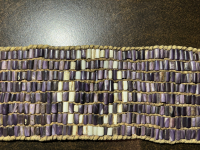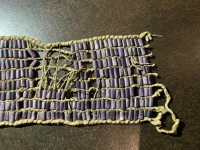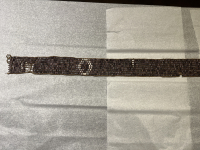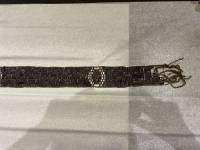wampum belt
wampum belt
wampum belt











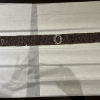



This relative, a wampum belt, is long and narrow. There are three white circles on a purple field. The belt has 8 horizontal rows of beads. One end of the belt has a fringe created from the warp. The other end of the belt appears to have been cut. The fringed end is a little narrower than the middle of the belt and the unfinished or cut end, though one edge narrows near the cut end as well. The weaving technique is that usually seen in wampum: the weft threads are woven so that they go in and out of the warp, attaching one bead at a time. The horizontal edges are finished with a leather edging technique that wraps around and between each bead. The origins of the belt are not certain, however it has probable connections to the Eastern Woodlands, the Haudenosaunee Confederacy and/or Quebec.
This relative currently resides at the Fisher Rare Book Library, University of Toronto.
Rare Book Library record suggests a possible affiliation with the Haudenosaunee Confederacy
University of Toronto Library catalogue and GRASAC researcher notes
Read More About This Relative
quahog, whelk, linen thread or vegetal fibre, hide/leather, possibly glass, ceramic or other kinds of shell beads
Warp is made of hide and is twisted. The weft could be linen thread or a hand-twined vegetal fibre. Follows conventional wampum weaving technique, with each bead woven in individually. The leather edging also wraps around/between each bead.
Three white circles are formed by beaded hexagons. The circles feature a double line of white beads on the sides, and a single line of white beads on the top and bottom. The double lines are separated by 1 purple bead.
The white circles generated much discussion among researchers. Alan Corbiere noted that Rick Hill has offered the interpretation that double circles can represent "Bringing the Dish Inside the Fort," building on the interpretation that circles refer to council fires. The group discussed whether these were concentric circles (one inside the other), or overlapping circles (like a Venn diagram). Alan Corbiere observed that both motifs exist on wampum belts, but usually when the circles are overlaid or overlapping, it is usually more explicit; on this belt, the purple that creates the two circle effect does not create clear overlapping or overlaid designs.
The cut end of the belt also generated much discussion. The team investigated the measurements between the white circles, as they discussed whether one or more circles may have been cut off. The group was cautious to not assume the circles were spaced symmetrically, or that there was a correlation between the distance between the circles and the amount of belt missing. The distance from the first circle near the fringed end to the second circle was 28 cm; then 47 cm between the next two circles; followed by 22 cm from the third circle to the cut/unfinished end. Comparisons were drawn to the Beaver Wars Belt, which was cut in half laterally but also shows signs that some pieces were cut out horizontally. The Double Calumet Pipe at the Pitt Rivers Museum also has one end with longer thongs, potentially long enough for there to have been another repeating pattern of the double calumets. An asymmetrical belt at the McCord Stewart Museum was also raised. All of these belts were noted to help the group think through possible scenarios for what happened with this belt, but researchers were cautious, and noted these possibilities remain as informed speculation.
Nyssa Komorowski observed that the weft could be linen thread, as it resembles linen thread she has seen elsewhere, and also resembles book-binding thread. Mikinaak Migwans observed it may more broadly be a hand-twined vegetal fibre weft.
Alan Corbiere noted Indigenous practices of cutting belts and distributing pieces and the re-purposing of beads from a belt to create strands or strings of wampum beads. He further noted examples from the Chandler-Pohrt collection at the Detroit Institute of Arts, where there is evidence collectors re-worked belts. It is difficult to determine when or why the end of this belt was modified.
Using a magnifying glass, the group looked for evidence of paint or ochre. There is a very small amount of reddish-brown residue on the white beads of the circle nearest the cut end, but it is difficult to confirm if this was intentionally-applied ochre or paint, or another substance.
Most of the beads are shell, though there are some grey-ish beads in the white sections that may be glass or a different material. The group looked closely at the beads using different light sources (LED lights on phones, and a light table) to try to assess the materials of the beads. There was variation in how light was able to pass through the white beads, but it was inconclusive whether this was a result of different kinds of shell, ceramic or porcelain, and/or glass materials.
Library catalogue record
Provenance
Thomas Fisher Rare Book Library bought the belt in 2016 from Neil David MacDonald, Toronto-based photography, rare book and fine art dealer. The belt had been in the estate of collector Robert D.W. Band.
Band bought the belt from collector and dealer Warren Baker, Montreal.
Baker bought the belt in 1988 from Bernard Lécuyer (also spelled L'Écuyer), a curator with a private museum in Montreal.
Lécuyer claimed he bought the belt from an Indigenous person.
Grant Hurley, Canadiana Librarian, Thomas Fisher Rare Book Library
Nikolaus Stolle's "Talking Beads" book, and especially the inventory of wampum belts (including belts held in private collections).
About This GRASAC Record
Maker, Name unknown. Wampum belt. GRASAC ID 59177. Thomas Fisher Rare Book Library Rare Book Collection.
This record was created by Cara Krmpotich on March 25, 2024. It draws on images and information recorded during a visit to the Fisher Rare Book Library, organized by Alan Corbiere on March 15, 2024. Present were GRASAC researchers Alan Corbiere, Mikinaak Migwans and Cara Krmpotich, as well as Brian Charles and Nyssa Komorowski. The group's visit was supported by Grant Hurley, Canadiana Librarian.
45.499288380121, -73.571797096147
Quebec is provided as a possible origin for this belt. "Montreal" is identified on the map, but this reflects one place in the belt's life. It is not a known place of origin.
 Knowledge Sharing Platform
Knowledge Sharing Platform


